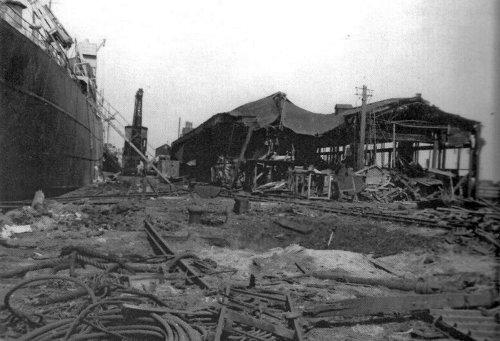Goering’s Gang are aloft!
Barrow Island was more than a number in Goering's little red book, it had a pin stuck in it on his wall map too. Lord
'Haw Haw' had already reminded our good townspeople, in his own inimitable fashion, that they "had not been forgotten,"
and a social call was the last thing these chaps had on their collectively psychotic minds.
Hermann Goering, made Reichsmarschall in 1940 after the success of the Polish blitzkrieg earlier that year, convinced
Hitler that his superlative Luftwaffe could subjugate the British by destroying the RAF in the sky then bombing the civilians'
morale to fragments.
Goering however, had several personality defects, which
not surprisingly went unnoticed among his psychopathic
friends. One of these quirks stemmed from childhood when
he and his family lived in rented accommodation. To eke out
the rent money, his mother, with his father's permission,
slept with their wealthy Jewish landlord. These childhood
memories tended, to put it mildly, cloud his judgement in his
dealings with the Jewish race in later life. Besides
transvestism, one of his other little foibles was his addiction
to morphine which imbued him with a cavalier attitude and a
state of mind where reality rarely trod. All in all, Goering's
wartime nick-name of; 'Der Dicke' needs no translation into
modern English, disappointingly it translates from the
German into a rather unspectacular, 'Fatty'.
Ignoring advice to mount a bombing campaign against
England when morale was low, immediately after the
shambles that was Dunkirk: Goering procrastinated. This
Francis Drake-like mood lasted some months, giving
England time to dust herself down and reappraise the
situation. The upshot of all this was that World War II didn't
arrive on Barrow's doorstep until 1941.
The blue-eyed zealots eventually turned up early in
April 1941 with the unavowed intention of destroying the
shipyard, among other things, and if the rest of Barrow
Island was reduced to rubble in the process - so much the
better. Considering residential Old Barrow was surrounded on all sides by the juicy targets of the shipyard. The docks on
other and what was then, the Oil Wells tank farm full of stored aviation fuel for the war effort, it is incredible that what
could have been a hideous holocaust was, from the German point of view, somewhat of a damp squib: for which the
islanders were truly thankful.
Most of the damage caused to housing was from blast
damage rather than direct hits, Aureool Terrace, a case in
point, was flattened by a land mine exploding in the Timber
Pond. Fortunately, the only casualty was a man who
preferred his bed to a cold air-raid shelter. He was lying in
bed when the blast caused the floor to collapse down to the
lower storey. Luckily he received only relatively minor
injuries. Aureool House standing but yards away, escaped
virtually unscathed. Its demise came in the 1980s, caused
by British bulldozers to make way for the British Gas
Condensate Plant which stands on the site of the old Oil
Wells.
A another row of cottages, demolished before the war,
to save Goering the trouble, stood quite close to Aureool
Terrace just inside the dock entrance in St Andrews Street.
They were built for the higher echelons of the workforce
building Ramsden Docks in the 1870s. Known as Foreman's
Cottages, they were respectable habitations of not only
foremen but on completion of the docks other professionals. In 1882 Issac Coombes a train driver occupied No2, Henry
Kendall Inspector of Rail Bridges was at No 9 and the Assistant Pier Master, John Lewis lived there. Over the years,
however, the cottages, although soundly built, deteriorated. In 1904 it was noted that fourteen cottages housed eighty-four
people.' One family made a few bob selling eggs and garden
produce from the doorstep until the 1930s when the town
council decided they were insanitary. In 1939 they were
demolished. Had the town council waited three years, Hitler
would have done it for them, in the bat of a bomb-aimer's
eye. The cottages' foundations next saw the light of day in
2008 during the landscaping operations for the new St
Andrew's allotments that occupy the spot now.
In the same groundworks, billets and a cook-house
which survived, as a store, were flattened. These were built
to accommodate men from the Manchester Regiment;
whose duty it was to patrol the docks and secure the
entrances including the one at St Andrew Street, with its
'White Gate.
Inside the 'White Gate' and over the railway lines, a
pillbox was constructed to cover the approach, just as
pillboxes and gun emplacements were built all over Barrow,
in readiness for the invasion that never came. A concrete
Anti-Aircraft Gun mounting still sits near the blockhouse in
Cavendish Park and another gun emplacement lies almost
hidden at the rear of the Timber Pond allotments in among the remnants of B.P's tank farm offices, all now completely
buried by the ‘Regeneration’ scheme.
If there were no other clues that the docks were once a mass of sprawling railway tracks and sidings, one would only
have to plot the positions of the pillboxes, although some have disappeared over the years. From the Cradle Bridge, past
Shipyard and Dockyard junctions off towards the Anchor Line Basin; and the single line to Ramsden Dock Station and the
deep-water berth jetties, all the railway lines were defended by pillboxes. Sited parallel to the track they guarded and were
so arranged that their arcs of fire covered virtually every square foot of dockland line, spur and junction.



Aureool terrace in the background.
Aureool House behind tree top, right



LEFT: Old pillbox guards Shipyard junction
ABOVE: Pillbox view of Nuclear ship

